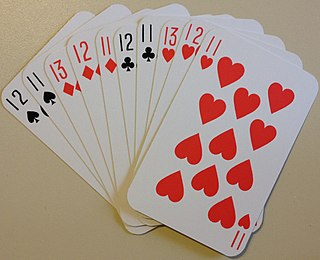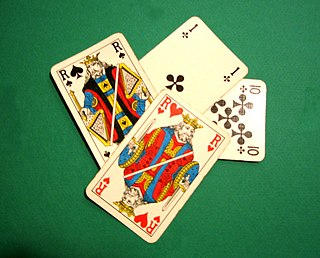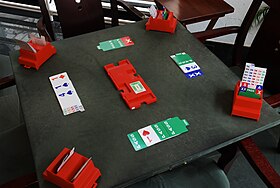
Contract bridge, or simply bridge, is a trick-taking card game using a standard 52-card deck. In its basic format, it is played by four players in two competing partnerships, with partners sitting opposite each other around a table. Millions of people play bridge worldwide in clubs, tournaments, online and with friends at home, making it one of the world's most popular card games, particularly among seniors. The World Bridge Federation (WBF) is the governing body for international competitive bridge, with numerous other bodies governing it at the regional level.

Pinochle, also called pinocle or penuchle, is a trick-taking, Ace-Ten card game typically for two to four players and played with a 48-card deck. It is derived from the card game bezique; players score points by trick-taking and also by forming combinations of cards into melds. It is thus considered part of a "trick-and-meld" category which also includes the game belote. Each hand is played in three phases: bidding, melds, and tricks. The standard game today is called "partnership auction pinochle".

500 or Five Hundred, also called Bid Euchre is a trick-taking game that is an extension of Euchre with some ideas from bridge. It can be played by two to six players, is most commonly played by four, in partnerships, and has also been recommended as a good three-player game. It arose in America before 1900 and was promoted by the US Playing Card Company, who copyrighted and marketed the rules in 1904. 500 is a social card game and was highly popular in the United States until around 1920 when first auction bridge and then contract bridge drove it from favour. It continues to be popular in Ohio and Pennsylvania, where it has been taught through six generations community-wide, and in other countries: Australia, New Zealand, Canada and Shetland. Despite its American origin, 500 is the national card game of Australia.

Forty-fives is a trick-taking card game that originated in Ireland. The game is popular in many communities throughout Atlantic Canada as well as the Gaspé Coast in Québec. Forty-fives is also played in parts of Massachusetts and southern New Hampshire in New England, United States, as well as in the South Island of New Zealand.
Rubber bridge is a form of contract bridge played by two competing pairs using a particular method of scoring. A rubber is completed when one pair becomes first to win two games, each game presenting a score of 100 or more contract points; a new game ensues until one pair has won two games to conclude the rubber. Owing to the availability of various additional bonus and penalty points in the scoring, it is possible, though less common, to win the rubber by amassing more total points despite losing two games out of three. Rubber bridge involves a high degree of skill but there is also a fair amount of luck involved in who gets the best cards. A popular variation of rubber bridge is known as Chicago.
A bridge convention is an agreement about an artificial call or a set of related artificial calls. Calls made during the auction phase of a contract bridge game convey information about the player's card holdings. Calls may be "natural" or "artificial".

In duplicate bridge, a board is an item of equipment that holds one deal, or one deck of 52 cards distributed in four hands of 13 cards each. The design permits the entire deal of four hands to be passed, carried or stacked securely with the cards hidden from view in four pockets. This is required for duplicate bridge tournaments, where the same deal is played several times and so the composition of each hand must be preserved during and after each play of each deal.
Pedreaux is an American trick-taking card game of the All Fours family based on Auction Pitch. Its most popular variant is known as Cinch, Double Pedro or High Five. Developed in Houma, Louisiana, by Chris Levron and Brad Greco in the 1880s, it was soon regarded as the most important member of the All Fours family. Although it went out of fashion with the rise of Auction Bridge, it is still widely played on the western coast of the United States and in its southern states, being the dominant game in some locations in Louisiana. Forms of the game have been reported from Nicaragua, the Azores, Niobe NY, Italy and Finland. The game is primarily played by four players in fixed partnerships, but can also be played by 2–6 individual players.
A bidding system in contract bridge is the set of agreements and understandings assigned to calls and sequences of calls used by a partnership, and includes a full description of the meaning of each treatment and convention. The purpose of bidding is for each partnership to ascertain which contract, whether made or defeated and whether bid by them or by their opponents, would give the partnership their best scoring result.
These terms are used in contract bridge, using duplicate or rubber scoring. Some of them are also used in whist, bid whist, the obsolete game auction bridge, and other trick-taking games. This glossary supplements the Glossary of card game terms.
Ulti or Ultimó, is Hungary's national trick-taking card game for three players. It is virtually unknown outside its home borders.
In the card game bridge, a forcing pass is an agreement or understanding that a pass call obliges the partner to bid, double, or redouble over an intermediate opposing pass, i.e. partner must "keep the bidding open".

A screen is a device used in some tournaments in duplicate bridge that visually separates partners at the table from each other, in order to reduce the exchange of unauthorized information and prevent some forms of cheating. It is a panel made of plywood, spanned canvas or similar material, which is placed vertically, diagonally across the playing table, with a small door in the center and a slit beneath it. The door is closed during the bidding stage, and the players place their calls using bidding cards on a movable tray, which slides under the door. After the opening lead, the door is opened, but its size allows the players only to see the hands and cards played from the opposite side of the screen, not their partner's face.
Contract bridge can be a friendly, informal social game, or a highly competitive mind-sport when in formal club or tournament play. The rules require players to conduct themselves ethically and to be courteous at all times. The rules of the game and expectations for ethical play are codified in the official Laws of Duplicate Contract Bridge and its published interpretations; the rules define which actions at the table are and are not permitted and remedies for rule infractions and irregularities. Players are expected to respect the norms of social courtesy and behavior; duplicate bridge sponsoring organizations can define additional standards for player's conduct, including the penalties for violation of personal conduct such as rudeness and other breaches of discipline not covered by applicable civil laws. Some aspects of the rules may be interpreted more strictly in a high-level tournament than in an informal social game.

Tarneeb, also spelled tarnibe and tarnib, and called hakam in the Persian Gulf region, is a plain trick-taking card game played in various Middle Eastern countries, most notably in the countries of the Levant, and Tanzania. The game may be considered a variation of Whist, or a version of Spades.
The Laws of Duplicate Bridge is the official rule book of duplicate bridge promulgated by the World Bridge Federation (WBF). The first Laws of Duplicate Contract Bridge were published in 1928. They were revised in 1933, 1935, 1943, 1949, 1963, 1975, 1987, 1997, 2007 and 2017. The Laws are effective worldwide for all duplicate bridge tournaments sponsored by WBF, zonal, national and subordinate organizations.
The support double is a bridge convention used to distinguish between three-card and four-card support for partner's suit response to one's opening bid in the scenario where his response is either overcalled or doubled by the opponents. A call of two in partner's suit indicates four-card support and a call of double promises three-card support; if partner's suit bid is doubled instead of overcalled, a redouble serves the same meaning as double. The convention was invented by Eric Rodwell in 1974.

Twenty-eight is an Indian trick-taking card game for four players, in which the Jack and the nine are the highest cards in every suit, followed by ace and ten. It thought to be descended from the game 304, along with similar Indian games known as "29", "40" and "56".
The Rosenkranz double and Rosenkranz redouble are elements of a bridge bidding convention invented by Dr. George Rosenkranz, collectively known as the Rosenkranz double. It is a double made by the advancer in an auction where opener, overcaller and responder have all bid different suits. It is used to describe the advancer's top honor card holdings in the overcaller's suit.

The following is a glossary of terms used in card games. Besides the terms listed here, there are thousands of common and uncommon slang terms. Terms in this glossary should not be game-specific, but apply to a wide range of card games. For glossaries that relate primarily to one game or family of similar games, see Game-specific glossaries.











